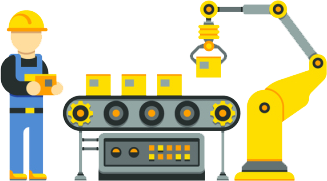Automated Powder Coating Production Line for Small Iron Parts
Detailed Description of an Automated Powder Coating Production Line for Small Iron Parts
1. Process Flow
1.1 Pre-treatment
Pre-treatment is a crucial step in the powder coating process, aimed at removing impurities from the surface of small iron parts to enhance coating adhesion and corrosion resistance. The specific steps include:
- Rust Removal: Using sandblasting or chemical rust removal methods to eliminate rust and oxide layers from the surface of iron parts. Sandblasting involves propelling abrasive materials (such as steel grit) with compressed air to remove surface roughness, while chemical rust removal uses acidic solutions to dissolve rust.
- Degreasing: Removing oil and grease from the surface of iron parts using alkaline cleaning agents through spraying or soaking. The surfactants in the cleaning agents emulsify the oils, causing them to separate from the surface of the iron parts.
- Water Washing: Multiple water washes to remove residual cleaning agents and impurities from the surface of the iron parts, ensuring cleanliness.
- Surface Adjustment: Treating the surface of iron parts with surface adjusters to form a uniform chemical film, providing a good foundation for subsequent phosphating treatment.
- Phosphating: Forming a phosphate film on the surface of iron parts to enhance coating adhesion and corrosion resistance. Phosphating treatment is usually carried out at room temperature or low temperature, generating a uniform phosphate film on the surface of iron parts through chemical reactions.
- Water Washing: Further water washing to remove residues after phosphating, ensuring the surface of the iron parts is clean.
1.2 Powder Coating
Powder coating involves evenly spraying powdered paint onto the surface of iron parts. The specific steps include:
- Electrostatic Powder Coating: Using electrostatic powder spray guns, which utilize electrostatic principles to evenly adhere powdered paint to the surface of iron parts. The spray guns, charged with high-voltage electricity, cause the powder to become electrified and adhere to the iron parts.
- Adjustment of Powder Coating Parameters: Adjusting parameters such as spray pressure, powder volume, and spray uniformity based on the shape and size of the iron parts. Spray pressure is typically between 0.2-0.5 MPa, and the powder volume is adjusted according to the surface area and coating thickness requirements of the iron parts.
- Powder Recovery: Unattached powder is recovered through a recycling system for reuse, improving powder utilization. The recycling system usually includes cyclone separators and filter core filters to ensure the quality of the recovered powder.
1.3 Curing
Curing involves baking the iron parts with powder coating at high temperatures to allow the powder coating to flow and cure. The specific steps include:
- Flow leveling: After powder coating, the iron parts enter the flow leveling room, where natural flow leveling or hot air circulation is used to evenly distribute the powder coating on the surface of the iron parts, avoiding defects such as orange peel and sagging.
- Curing: The iron parts enter the curing oven, where a hot air circulation heating system is used to cure the powder coating at high temperatures. Curing temperatures are typically between 180-220°C, and curing times are adjusted based on the type of powder coating and the thickness of the iron parts.
- Cooling: After curing, the iron parts are cooled through natural cooling or forced cooling methods to ensure the stability and hardness of the coating.
2. Equipment Composition
2.1 Conveying System
The conveying system is responsible for the automated transportation of iron parts, ensuring the continuity of the production process. The specific equipment includes:
- Overhead Conveyor Chain: Used to suspend iron parts and move them between different stations through chain drive. The overhead conveyor chain has stable performance and high load capacity.
- Lifting Mechanism: Between the powder coating room and the curing oven, the lifting mechanism transfers iron parts from the overhead conveyor chain to the conveyor belt in the powder coating room or curing oven. The lifting mechanism is driven by hydraulic or pneumatic power to ensure smooth operation.
- Automatic Positioning Device: Ensuring that iron parts maintain an accurate position during powder coating and curing processes, improving coating quality and production efficiency.
2.2 Powder Coating Equipment
Powder coating equipment is the core part of the powder coating process, ensuring that powdered paint is evenly sprayed onto the surface of iron parts. The specific equipment includes:
- Electrostatic Powder Spray Gun: Utilizing electrostatic principles to evenly adhere powdered paint to the surface of iron parts. Spray guns come in various models, which can be selected based on the shape and size of the iron parts.
- Powder Supply System: Providing powdered paint for the spray gun to ensure a stable supply of powder. The powder supply system includes powder buckets, powder pumps, and powder conveying pipes, which transport powder to the spray gun through pneumatic or mechanical means.
- Recycling System: Recovering unattached powder to improve powder utilization. The recycling system includes cyclone separators and filter core filters to ensure the quality of the recovered powder.
2.3 Curing Equipment
Curing equipment is responsible for baking iron parts with powder coating at high temperatures to allow the powder coating to flow and cure. The specific equipment includes:
- Curing Oven: Using hot air circulation heating to ensure uniform curing of the coating. The curing oven is equipped with a temperature control system to precisely control the curing temperature.
- Flow Leveling Room: Using natural flow leveling or hot air circulation to evenly distribute the powder coating on the surface of the iron parts, avoiding defects such as orange peel and sagging.
- Cooling Device: After curing, the iron parts are cooled through natural cooling or forced cooling methods to ensure the stability and hardness of the coating.
2.4 Control System
The control system is the "brain" of the entire production line, coordinating the operation of each piece of equipment to achieve automated production. The specific functions include:
- Automated Control: Using advanced automated control systems to achieve fully automated operation from loading to unloading. The control system can set and adjust the operating parameters of each piece of equipment to ensure the stability and consistency of the production process.
- Parameter Setting and Adjustment: Through touch screens or control panels, operators can conveniently set and adjust the operating parameters of each piece of equipment, such as conveying speed, spray pressure, and curing temperature.
- Fault Diagnosis and Alarm: The control system has functions for fault diagnosis and alarms, which can promptly detect and handle equipment failures, improving production efficiency and equipment reliability.
3. Technical Parameters
3.1 Powder Coating Thickness
Powder coating thickness is generally controlled between 50-120 micrometers, with the specific thickness determined based on the usage requirements and environmental conditions of the iron parts. The uniformity of coating thickness is an important indicator of powder coating quality, ensured by adjusting spray parameters and equipment performance.
3.2 Powder Utilization Rate
The utilization rate of powdered paint is approximately above 95%. Through an efficient recycling system, unattached powder can be recovered and reused, reducing waste and lowering production costs.
3.3 Production Efficiency
The automated production line greatly increases production efficiency, enabling large-scale continuous production. Conveying speed can be adjusted according to production requirements, and the capacity of a single production line can be optimized based on the size and quantity of iron parts.
4. Features
4.1 Environmental Protection and Energy Saving
The powder coating process does not contain solvents, solving pollution problems caused by solvents. At the same time, water circulation systems achieve the recycling of water resources, reducing production costs. The curing oven uses hot air circulation heating, which has good thermal insulation and saves energy.
4.2 High Coating Quality
Powder coatings have good adhesion, corrosion resistance, and wear resistance, with a uniform and smooth appearance. By precisely controlling powder coating parameters and curing conditions, the consistency and stability of coating quality are ensured.
4.3 High Degree of Automation
The production line uses automated control technology to achieve fully automated operation from loading to unloading, reducing manual intervention and improving production efficiency and product quality. The control system has functions for fault diagnosis and alarms, ensuring reliable equipment operation.
4.4 Wide Range of Applications
The automated powder coating production line for small iron parts is suitable for surface treatment of various small iron parts, such as hardware parts, mechanical components, and automotive parts. The production line can be flexibly adjusted based on the shape and size of the iron parts to meet different production requirements.
5. Application Fields
The automated powder coating production line for small iron parts is widely used in the hardware manufacturing, mechanical processing, and automotive parts manufacturing industries. Its efficient, environmentally friendly, and automated characteristics make it an indispensable piece of equipment in modern manufacturing. It can effectively improve production efficiency and product quality, meeting the high standards for surface treatment of small iron parts in the market.
The automated powder coating production line for small iron parts is designed for efficient surface treatment. It includes pre-treatment steps like rust removal, degreasing, and phosphating to enhance coating adhesion. The powder coating process uses electrostatic spray guns for uniform application, with adjustable parameters for different part sizes. The curing process involves high-temperature baking in a hot air circulation oven to ensure a smooth, durable finish. The line features automated conveying, precise controls, and powder recovery systems for high efficiency and environmental protection. Suitable for hardware, mechanical components, and automotive parts, this line boosts production efficiency and coating quality.
Factory address: East Industrial Cluster, Wenling City, Zhejiang Province
Aircraft: Taizhou Luqiao Airport (1 hour) Wenzhou Airport (2 hours)
High speed rail: Wenling Station (40 minutes)
Expressway intersection: Wenling North (15 minutes) Wenling East (20 minutes)
Contact our engineering team and get company info
Email: Assemblyline@qq.com






